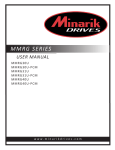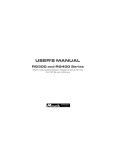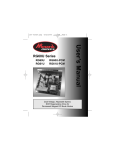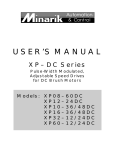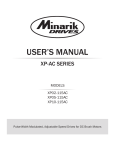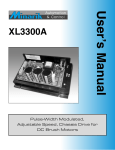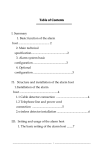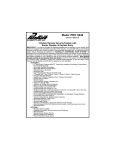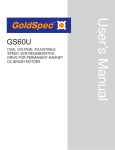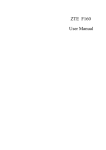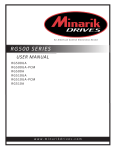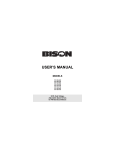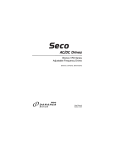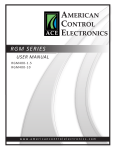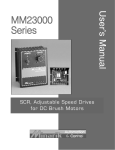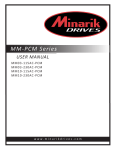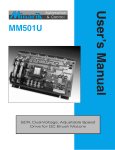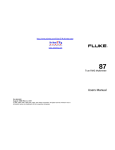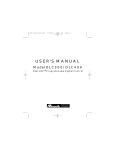Download User`s Manual
Transcript
Models MMRG30U MMRG31U MMRG40U MMRG30U-PCM MMRG31U-PCM MMRG40U-PCM Four-Quadrant, Regenerative Drives for DC Motors User’s Manual MMRG Copyright © 2001 by Minarik Corporation All rights reserved. No part of this manual may be reproduced or transmitted in any form without written permission from Minarik Corporation. The information and technical data in this manual are subject to change without notice. Minarik Corporation and its Divisions make no warranty of any kind with respect to this material, including, but not limited to, the implied warranties of its merchantability and fitness for a given purpose. Minarik Corporation and its Divisions assume no responsibility for any errors that may appear in this manual and make no commitment to update or to keep current the information in this manual. Printed in the United States of America. i Safety Warnings • This symbol denotes an important safety tip or warning. Please read these instructions carefully before performing any of the procedures contained in this manual. • DO NOT INSTALL, REMOVE, OR REWIRE THIS EQUIPMENT WITH POWER APPLIED. Have a qualified electrical technician install, adjust and service this equipment. Follow the National Electrical Code and all other applicable electrical and safety codes, including the provisions of the Occupational Safety and Health Act (OSHA), when installing equipment. • Reduce the chance of an electrical fire, shock, or explosion by proper grounding, over-current protection, thermal protection, and enclosure. Follow sound maintenance procedures. It is possible for a drive to run at full speed as a result of a component failure. Minarik strongly recommends the installation of a master switch in the main power input to stop the drive in an emergency. Circuit potentials are at 115 VAC or 230 VAC above earth ground. Avoid direct contact with the printed circuit board or with circuit elements to prevent the risk of serious injury or fatality. Use a non-metallic screwdriver for adjusting the calibration trimpots. Use approved personal protective equipment and insulated tools if working on this drive with power applied. ii Contents Regenerative Drives v Specifications 1 Dimensions 2 Installation 5 Mounting . . . . . . . . . . . . . . . . . . . . . . . . . . . . . . . . . . . . . . . . . . . . .5 Wiring . . . . . . . . . . . . . . . . . . . . . . . . . . . . . . . . . . . . . . . . . . . . . . .6 Shielding guidelines . . . . . . . . . . . . . . . . . . . . . . . . . . . . . . . . . . .7 Heat sinking . . . . . . . . . . . . . . . . . . . . . . . . . . . . . . . . . . . . . . . . . .8 Speed adjust potentiometer . . . . . . . . . . . . . . . . . . . . . . . . . . . . . . .9 Power, fuse and motor connections . . . . . . . . . . . . . . . . . . . . . .10 Motor . . . . . . . . . . . . . . . . . . . . . . . . . . . . . . . . . . . . . . . . . . . .10 Connections . . . . . . . . . . . . . . . . . . . . . . . . . . . . . . . . . . . . . . . . . .10 Power input . . . . . . . . . . . . . . . . . . . . . . . . . . . . . . . . . . . . . . . .11 Line fuse . . . . . . . . . . . . . . . . . . . . . . . . . . . . . . . . . . . . . . . . . .11 Voltage follower . . . . . . . . . . . . . . . . . . . . . . . . . . . . . . . . . . . . . .15 Voltage follower (-PCM models) . . . . . . . . . . . . . . . . . . . . . . . . . .16 Polarity reversal switch (-PCM models) . . . . . . . . . . . . . . . . . . . . .16 +15 and –15 terminals . . . . . . . . . . . . . . . . . . . . . . . . . . . . . . . . . .18 Line frequency switch . . . . . . . . . . . . . . . . . . . . . . . . . . . . . . . . . .19 Operation 20 Before applying power: . . . . . . . . . . . . . . . . . . . . . . . . . . . . . . . . .20 Startup and shutdown . . . . . . . . . . . . . . . . . . . . . . . . . . . . . . . . . .21 To start the drive: . . . . . . . . . . . . . . . . . . . . . . . . . . . . . . . . . . .21 Automatic restart upon power restoration . . . . . . . . . . . . . . . . . .22 Starting and Stopping Methods . . . . . . . . . . . . . . . . . . . . . . . . . .22 Decelerate to a stop . . . . . . . . . . . . . . . . . . . . . . . . . . . . . . . . .23 Regenerative brake . . . . . . . . . . . . . . . . . . . . . . . . . . . . . . . . . .24 iii Calibration 25 MAX SPD . . . . . . . . . . . . . . . . . . . . . . . . . . . . . . . . . . . . . . . . . . .27 FORWARD TORQUE . . . . . . . . . . . . . . . . . . . . . . . . . . . . . . . . . . .28 REVERSE TORQUE . . . . . . . . . . . . . . . . . . . . . . . . . . . . . . . . . . .29 IR COMP . . . . . . . . . . . . . . . . . . . . . . . . . . . . . . . . . . . . . . . . . . .30 ACC–DEC . . . . . . . . . . . . . . . . . . . . . . . . . . . . . . . . . . . . . . . . . .31 FWD SIG ADJ (-PCM models) . . . . . . . . . . . . . . . . . . . . . . . . . . .32 REV SIG ADJ (-PCM models) . . . . . . . . . . . . . . . . . . . . . . . . . . . .32 Application Notes 34 Connection to Minarik DLC600 . . . . . . . . . . . . . . . . . . . . . . . . . . . .34 FWD-REV switch . . . . . . . . . . . . . . . . . . . . . . . . . . . . . . . . . . . . .35 FWD-STOP-REV switch . . . . . . . . . . . . . . . . . . . . . . . . . . . . . . . .36 Independent Adjustable Speeds . . . . . . . . . . . . . . . . . . . . . . . . . .37 Independent forward and reverse speeds . . . . . . . . . . . . . . . . . . .38 Independent foward and reverse speeds with FWD-STOP-REV switch . . . . . . . . . . . . . . . . . . . . . . . . . . . . . .39 Troubleshooting 40 Before applying power . . . . . . . . . . . . . . . . . . . . . . . . . . . . . . . . .40 Replacement Parts . . . . . . . . . . . . . . . . . . . . . . . . . . . . . . . . . . . .44 Certificate of Compliance 45 AC Line Filters . . . . . . . . . . . . . . . . . . . . . . . . . . . . . . . . . . . . . . .46 Armature Filters . . . . . . . . . . . . . . . . . . . . . . . . . . . . . . . . . . . . . .47 Unconditional Warranty inside back cover Tables Table 1. Recommended Line Fuse Sizes . . . . . . . . . . . . . . . . . . . . .12 Table 2. Replacement Parts . . . . . . . . . . . . . . . . . . . . . . . . . . . . . . .44 Table 3. AC Line Filters . . . . . . . . . . . . . . . . . . . . . . . . . . . . . . . . . .46 Table 4. Armature Filters . . . . . . . . . . . . . . . . . . . . . . . . . . . . . . . . .47 iv Illustrations Figure 1. Four Quadrant Operation . . . . . . . . . . . . . . . . . . . . . . . . . . .vi Figure 2. MMRG Dimensions . . . . . . . . . . . . . . . . . . . . . . . . . . . . . . .2 Figure 3. MMRG Dimensions (Drive mounted on 223–0159 heat sink kit) . . . . . . . . . . . . . .3 Figure 4. MMRG-PCM Dimensions . . . . . . . . . . . . . . . . . . . . . . . . . . .4 Figure 5. Speed Adjust Potentiometer . . . . . . . . . . . . . . . . . . . . . . . . .9 Figure 6. Power and Motor Connections . . . . . . . . . . . . . . . . . . . . . .13 Figure 7. Speed Adjust Potentiometer Connections . . . . . . . . . . . . .14 Figure 8. Voltage Follower Connection . . . . . . . . . . . . . . . . . . . . . . .15 Figure 9. Voltage Follower Connection (-PCM Models) . . . . . . . . . . .17 Figure 10. +15 and -15 Terminal Locations . . . . . . . . . . . . . . . . . . . .18 Figure 11. Line Frequency Switch . . . . . . . . . . . . . . . . . . . . . . . . . . .19 Figure 12. RUN/STOP Switch . . . . . . . . . . . . . . . . . . . . . . . . . . . . . .23 Figure 13. INHIBIT Terminals . . . . . . . . . . . . . . . . . . . . . . . . . . . . . .24 Figure 14. Calibration Trimpot Layout . . . . . . . . . . . . . . . . . . . . . . . .26 Figure 15. Recommended IR COMP, REVERSE TORQUE, and FORWARD TORQUE Settings . . . . . . . . . . . . . . . . . . . . . . . . . . . . . .33 Figure 16. MMRG Connection to DLC600 . . . . . . . . . . . . . . . . . . . . .34 Figure 17. Forward-Reverse Switch . . . . . . . . . . . . . . . . . . . . . . . . . .35 Figure 18. Forward-Stop-Reverse Switch . . . . . . . . . . . . . . . . . . . . . .36 Figure 19. Independent Adjustable Speeds (Forward Direction) . . . . .37 Figure 20. Independent Forward and Reverse Speeds . . . . . . . . . . . .38 Figure 21. Independent Forward and Reverse Speeds with a ForwardStop-Reverse Switch . . . . . . . . . . . . . . . . . . . . . . . . . . . . . . . . . . . . .39 v Regenerative Drives Most non-regenerative, variable speed, DC drives control current flow to a motor in one direction. The direction of current flow is the same direction as the motor rotation. Non-regenerative drives operate in Quadrant 1, and also in Quadrant 3 if the drive is reversible (see Figure 1). Motors must stop before reversing direction. Unless dynamic braking is used, non-regenerative drives cannot oppose an overhauling load, and cannot decelerate a load faster than coasting to a lower speed. Regenerative drives operate in two additional quadrants: Quadrant 2 and Quadrant 4. In these quadrants, motor torque is in the opposite direction of motor rotation. This allows regenerative drives to reverse a motor without contactors or switches, to control an overhauling load, and to decelerate a load faster than it would take to coast to a lower speed. vi Regenerative Drives Figure 1. Four Quadrant Operation 1 Specifications Maximum Model (Amps DC) MMRG30U, MMRG30U-PCM MMRG31U, MMRG31U-PCM MMRG40U, MMRG40U-PCM Armature Current Range 5.0* 3.0 5.0** Armature Horsepower (Volts DC) 1/8–1/2* 1/20–1/8 1/4 - 1** Voltage Range 0 – 90 0 – 90 0 – 180 * Max. Armature Current = 10 ADC Max. Horsepower = 1 hp when mounted to heat sink kit part number 223–0159. ** Max. Armature Current = 10 ADC Max. Horsepower = 2 hp when mounted to heat sink kit part number 223–0159. AC Line Voltage MMRG30U, MMRG30U-PCM 115 VAC, ±10%, 50/60 Hz, single phase MMRG31U, MMRG31U-PCM 115 VAC, ±10%, 50/60 Hz, single phase MMRG40U, MMRG40U-PCM 230 VAC, ±10%, 50/60 Hz, single phase Form Factor 1.37 at base speed Acceleration Time Range 0.5 – 6 seconds Deceleration Time Range 0.5 – 6 seconds Analog Input Voltage Range (signal must be isolated; S1 to S2) Input Impedance (S0 to S2) Load Regulation Vibration 0 ± 10 VDC 30 kohms 1% base speed 0.5G max. (20–50 Hz) 0.1G max. (>50 Hz) Ambient Temperature Range Weight 10°C–55°C 1.1 lb * With the -PCM option, a drive can be configured to follow a grounded non-isolated voltage signal. 2 Dimensions S0 S3 S1 COMMON 0.99 [25] DC VOLTAGE S2 C 5 11 C 5 10 C 5 12 DC VOLTAGE C503 C509 + 15 V MMRG DC VOLTAGE C505 C508 C506 C507 DC VOLTAGE - 15 V 3.72 [94] 50HZ T5 0 1 SW501 PL2 1.75 [44] 60HZ C 5 13 SO501 INHIB IT C501 P501 P502 P503 P504 P505 C502 AC C - DE C M AX SPD IR C OM P REVERSE FORW ARD TORQUE TORQUE 2.87 [73] 0.96 [24] 3.80 [97] 4.30 [109] 4.42 [112] ALL DIMENSIONS IN INCHES [MILLIMETERS] MOUNTING SLOTS 0.19 X 3.4 [5 X 9] Figure 2. MMRG Dimensions PL1 Dimensions 3 6.90 [175] 6.30 [160] 5.90 [150] S0 S3 S1 DC VOLTAGE C OM M O N S2 C 5 11 C 5 10 C 5 12 DC VOLTAGE C503 C509 + 15V M MRG DC VOLTAGE C505 C508 C506 C507 DC VOLTAGE - 15V 5 0H Z T50 1 PL1 S W 5 01 PL2 4.40 [112] 6 0H Z C 5 13 S O50 1 IN H IB IT 3.70 [94] C501 P5 01 P5 03 P5 02 P5 04 P5 05 C502 A C C - DEC MAX SPD IR C O M P REV E RSE FORW ARD TORQUE TORQUE 0.70 [18] 3.87 [98] 1.00 [25] ALL DIMENSIONS IN INCHES [MILLIMETERS] MOUNTING SLOTS 0.19 X 3.4 [5 X 9] Figure 3. MMRG Dimensions (Drive mounted on 223–0159 heat sink kit) 0.13 [3] 4 Dimensions S0 S3 COMMON 1.75 [44] T502 3.72 [94] FWD SIG ADJ REV SIG ADJ T501 0.99 [25] 4.10 [104] SO 501 TB501 DIR IN H IB IT P501 P502 P503 P504 COM NEG P505 POS AC C - DEC M AX SPD IR C O M P REVERSE FO RW ARD TO RQUE TO RQUE DIR COM NEG POS 3.375 [86] 0.96 [24] 4.30 [109] 4.42 [112] ALL DIMENSIONS IN INCHES [MILLIMETERS] MOUNTING SLOTS 0.19 X 3.4 [5 X 9] Figure 4. MMRG-PCM Dimensions 5 Installation Mounting Warning Do not install, rewire, or remove this control with input power applied. Doing so may cause fire or serious injury. Make sure you have read and understood the Safety Warnings on page i before attempting installation. • Drive components are sensitive to electrostatic fields. Avoid direct contact with the circuit board. Hold drive by the chassis only. • Protect the drive from dirt, moisture, and accidental contact. Provide sufficient room for access to the terminal block and calibration trimpots. • Mount the drive away from heat sources. Operate the drive within the specified ambient operating temperature range. • Prevent loose connections by avoiding excessive vibration of the drive. • Mount drive with its board in either a horizontal or vertical plane. Six 0.19 in. (5 mm) wide slots in the chassis accept #8 pan head screws. Fasten either the large base or the narrow flange of the chassis to the subplate. • The chassis must be earth grounded. Use a star washer beneath the head of at least one of the mounting screws to penetrate the anodized chassis surface and to reach bare metal. 6 Installation Wiring Warning Do not install, remove, or rewire this equipment with power applied. Failure to heed this warning may result in fire, explosion, or serious injury. Circuit potentials are at 115 or 230 VAC above ground. To prevent the risk of injury or fatality, avoid direct contact with the printed circuit board or with circuit elements. Do not disconnect any of the motor leads from the drive unless power is removed and the drive is disabled. Opening any one motor lead may destroy the drive. • Use 18 AWG wire for speed adjust potentiometer wiring. Use 16 AWG wire for field (F1, F2) wiring. Use 14 AWG wire for AC line (L1, L2) and motor (A1, A2) wiring. Installation 7 Shielding guidelines Warning Under no circumstances should power and logic leads be bundled together. Induced voltage can cause unpredictable behavior in any electronic device, including motor controls. As a general rule, Minarik recommends shielding of all conductors. If it is not practical to shield power conductors, Minarik recommends shielding all logic-level leads. If shielding logic leads is not practical, the user should twist all logic leads with themselves to minimize induced noise. It may be necessary to earth ground the shielded cable. If noise is produced by devices other than the drive, ground the shield at the drive end. If noise is generated by a device on the drive, ground the shield at the end away from the drive. Do not ground both ends of the shield. If the drive continues to pick up noise after grounding the shield, it may be necessary to add AC line filtering devices, or to mount the drive in a less noisy environment. 8 Installation Logic wires from other input devices, such as motion controllers and PLL velocity controllers, must be separated from power lines in the same manner as the logic I/O on this drive. Heat sinking MMRG Series drives require an additional heat sink when the continuous armature current is above 5 ADC. Use Minarik heat sink kit part number 223-0159. Use a thermally conductive heat sink compound (such as Dow Corning® 340 Heat Sink compound) between the drive chassis and the heat sink surface for optimum heat transfer. Model MMRG31U does not require an additional heat sink. Installation 9 Speed adjust potentiometer Warning Be sure that the potentiometer tabs do not make contact with the potentiometer enclosure. Grounding the input will cause damage to the drive. Mount the speed adjust potentiometer through a 0.38 in. (10 mm) hole with the hardware provided (Figure 5). Install the circular insulating disk between the panel and the 10K ohm speed adjust potentiometer. Twist the speed adjust potentiometer wire to avoid picking up unwanted electrical noise. If speed adjust potentiometer wires are longer than 18 in. (457 mm), use shielded cable. Keep speed adjust potentiometer wires separate from power leads (L1, L2, A1, A2). MOUNT THROUGH A 0.38 IN. (10 MM) HOLE CW WIPER CCW NUT STAR WASHER SPEED ADJUST POTENTIOMETER INSULATING DISK POT TAB ASSIGNMENTS PANEL Figure 5. Speed Adjust Potentiometer 10 Installation Connections Warning Do not connect this equipment with power applied. Failure to heed this directive may result in fire or serious injury. Minarik strongly recommends the installation of a master power switch in the voltage input line, as shown in Figure 6, page 13. The switch contacts should be rated at a minimum of 200% of motor nameplate current and 250 volts. Power, fuse and motor connections Connect the power input leads, an external line fuse and a DC motor to the drive’s printed circuit board (PCB) as shown in Figure 6, page 13. Installation 11 Motor Minarik drives supply motor voltage from A1 and A2 terminals. It is assumed throughout this manual that, when A1 is positive with respect to A2 , the motor will rotate clockwise (CW) while looking at the output shaft protruding from the front of the motor. If this is opposite of the desired rotation, simply reverse the wiring of A1 and A2 with each other. Connect a DC motor armature to PCB terminals A1 and A2 as shown in Figure 6, page 13. Ensure that the motor voltage rating is consistent with the drive’s output voltage. Power input Connect the AC line power leads to terminals L1 and L2, or to a double-throw, single-pole master power switch (recommended). Line fuse Minarik drives require fuses for protection. Use fast acting fuses rated for 250 VAC or higher, and approximately 150% of the maximum armature current. Fuse L1 only when the line voltage is 115 VAC. Fuse both L1 and L2 when the line voltage is 230 VAC. 12 Installation Wire an external line fuse between the stop switch (if installed) and the terminal board. An additional line fuse should be installed on L2 if the input voltage is 230 VAC. Refer to the line fuse chart below for fuse ratings. Table 1. Recommended Line Fuse Sizes 90 VDC Motor 180 VDC Motor Max. DC Armature AC Line Fuse Horsepower Horsepower Current (amps) Size (amps) 1/20 1/10 0.5 3 1/15 1/8 0.8 3 1/8 1/4 1.5 5 1/6 1/3 1.7 5 1/4 1/2 2.5 8 1/3 3/4 3.5 8 1/2 1 5.0 10 3/4 1 1/2 7.5 15 1 2 10 20 Minarik Corporation offers two fuse kits: part number 050–0069 (3–8A Fuse Kit) and 050–0073 (5–20A Fuse Kit). Both fuse kits include a 1/2A pico fuse (part number 050–0064) which protects the transformer and logic. Installation 13 MMRG BOTTOM BOARD SC R 504 SC R 503 SC R 502 SC R 501 E ARTH GND G ND T503 L1 AC VOLTAGE C 501 T504 R 501 R 502 A1 DC VOLTAGE C 502 T501 C 508 SO5 04 AC VOLTAGE L2 T502 MOTOR R 503 C 505 MMRG DC VOLTAGE SC R 505 SC R 506 SC R 507 SC R 508 Master Power Switch SO5 01 SO5 02 M O V501 C 504 FUSE FUSE* C 506 C 507 C 503 FU5 01 SO5 03 EARTH GROUND A2 115 VAC 90 VDC MOTOR MMRG30U, MMRG30U-PCM MMRG31U, MMRG 31U-PCM MMRG30U, MMRG30U-PCM MMRG31U, MMRG31U-PCM or 230 VAC or 180 VDC MOTOR MMRG40U, MMRG 40U-PCM (MMRG40U) * Add fuse to L2 with 230 VAC input only. Figure 6. Power and Motor Connections 14 Installation REVERSE FORW ARD CW S1 S0 COMMON S3 C512 S2 C510 C511 DC VOLTAGE DC VOLTAGE C509 (a) Bidirectional Operation R EVE R S E CW CW (b) Unidirectional Operation, Forward Direction C510 S2 C 5 09 S1 S2 DC VOLTAGE S0 DC VOLTAGE C512 C 5 10 C 5 11 COMMON S3 S1 S0 C OM MON S3 C 5 12 FORW ARD C511 D C V O LTA G E D C V O LTA G E C509 (c) Unidirectional Operation, Reverse Direction Figure 7. Speed Adjust Potentiometer Connections Installation 15 Voltage follower The drive may be wired to follow a floating (isolated) 0 to ±10VDC signal that is isolated from earth ground instead of using a speed adjust potentiometer. Connect the signal input to S2, and the signal common to S0 (see Figure 8). SIGNAL ±10 VDC COMMON SIGNAL S1 S0 C OM M ON S3 C 510 S2 C 512 C 511 D C VO LTA G E D C VO LTA G E C 503 C 509 C 505 Figure 8. Voltage Follower Connection 16 Installation Voltage follower (-PCM models) PCM series drives can be configured to follow a grounded (nonisolated) voltage signal. To configure the drive to follow a voltage signal, connect the signal leads to the SIGNAL INPUT POS and SIGNAL INPUT NEG terminals, observing proper polarity. Note: There are two locations where signal input connections can be made, either to terminals TB501 or to the faston terminal posts located below TB501. (see figure 9, page 17) Polarity reversal switch (-PCM models) To reverse the output voltage polarity without changing the input polarity, connect DIR to COM. A single-pole, single-throw switch can be used as a polarity reversal switch. Close the switch to reverse the output voltage polarity. Open the switch to return the output voltage back to its original polarity. See Figure 9, page 17 for polarity reversal switch connections. 17 T502 FWD SIG ADJ REV Installation DIR SWITCH TB501 DIR OPEN OR CLOSE TO CHANGE DIRECTION COM NEG POS WARD QUE DIR COM NEG POS POS (+) NEG (-) 0 TO ±10 VDC VOLTAGE SIGNAL INPUT FAST-ON TERMINALS PARALLEL TB501 Figure 9. Voltage Follower Connection (-PCM Models) 18 Installation +15 and –15 terminals Warning Do not short the +15 and -15 terminals for any reason. Shorting these terminals may damage the drive. The MMRG Series drives can supply a regulated +15 and –15 VDC signal (each sourcing 15 mA maximum) to isolated, external devices. See Figure 10 for the voltage supply terminal locations. S0 S3 S1 COM M ON D C VO LT A GE S2 C 5 11 C 5 12 C 5 10 D C VO LT A GE C509 + 15 V D C VO LT A GE C505 D C VO LT A GE - 15 V T5 0 1 Figure 10. +15 and -15 Terminal Locations +15V TERMINAL -15V TERMINAL Installation 19 Line frequency switch SW501 of the top board is the line frequency switch (see Figure 11). Set the switch to 50HZ if the line frequency is 50 Hz, or to 60HZ if the line frequency is 60 Hz. S1 DC VOLTAGE S2 S0 CO M M ON S3 C 5 10 C 5 12 C 5 11 DC VOLTAGE C503 MMRG C509 C505 IC 5 0 2 IC 5 0 1 C508 C506 C507 T5 0 1 P L1 50HZ 60HZ SW501 P L2 C 5 13 SO501 C501 IN H IB IT P501 P502 P503 P504 P505 C504 C502 A C C - D EC MAX SPD IR C O M P R EV ER S E FO R W A R D TO R Q U E TO R Q U E Figure 11. Line Frequency Switch Line Frequency Switch 20 Operation Warning Dangerous voltages exist on the drive when it is powered. BE ALERT. High voltages can cause serious or fatal injury. For your safety, use personal protective equipment (PPE) when operating this drive. Before applying power: • Verify that no conductive material is present on the printed circuit board. • Ensure that all jumpers are properly set. Operation 21 Startup and shutdown To start the drive: 1. Set the speed adjust potentiometer for zero speed, or the reference voltage to zero, if in voltage follower mode. 2. Apply AC line voltage. 3. Slowly turn the speed adjust potentiometer clockwise or counterclockwise to rotate the motor in the forward or reverse direction. If in voltage follower mode, increase reference voltage in the positive or negative direction. Continue until the desired speed is reached. 4. To decelerate the motor from set speed to a stop, reset the speed adjust potentiometer for zero speed. If in voltage follower mode, decrease reference voltage to zero. To coast the motor from set speed to a stop, remove AC line voltage from the drive. If the motor or drive does not perform as described, disconnect the AC line voltage immediately. Refer to the Troubleshooting section for further assistance. 22 Operation Starting and Stopping Methods Warning Decelerating to minimum speed, regenerative braking, or coasting to a stop is recommended for frequent starts and stops. Do not use any of these methods for emergency stopping. They may not stop a drive that is malfunctioning. Removing AC line power (both L1 and L2) is the only acceptable method for emergency stopping. For this reason, Minarik strongly recommends installing an emergency stop switch on both the L1 and L2 inputs (see Connections section - page 11). Frequent decelerating to minimum speed or regenerative braking produces high torque. This may cause damage to motors, especially gearmotors that are not properly sized for the application. Automatic restart upon power restoration All drives automatically run to set speed when power is applied. Operation 23 Decelerate to a stop The RUN/STOP switch in Figure 12 may be used to decelerate a motor to a stop. Closing the switch between S2 and S0 decelerates the motor from set speed to a stop. The ACC–DEC trimpot setting determines the rate at which the drive accelerates and decelerates. Set the switch to the RUN position to accelerate the motor to set speed. CW RUN STOP DC VOLTAGE S2 C 511 S1 S0 C O M M ON S3 C 510 C 512 DC VOLTAGE C 503 C 509 IC 502 C 505 IC 501 C C 507 T501 Figure 12. RUN/STOP Switch 24 Operation Regenerative brake Short the INHIBIT terminals to regeneratively brake the motor (see Figure 13 for INHIBIT terminal location). Reopening the INHIBIT terminals causes the motor to accelerate to set speed. Minarik Corporation offers two accessory plug harnesses for the INHIBIT terminals: Minarik Part Number 201-0024 201-0079 Description Inhibit plug with 18 in. (46 cm) wires Inhibit plug with 36 in. (91 cm) wires Twist inhibit wires and separate them from other power-carrying wires or other sources of electrical noise. Use shielded cable if the inhibit wires are longer than 18 in. (46 cm). If shielded cable is used, ground only one end of the shield to earth ground. Do not ground both ends of the shield. P L2 C 5 13 SO501 INHIBIT Terminals C501 IN H IB IT P501 P502 P503 P504 P505 C504 C502 Figure 13. INHIBIT Terminals 25 Calibration Warning Dangerous voltages exist on the drive when it is powered. When possible, disconnect the voltage input from the drive before adjusting the trimpots. If the trimpots must be adjusted with power applied, use insulated tools and the appropriate personal protection equipment. BE ALERT. High voltages can cause serious or fatal injury. MMRG Series drives have five user adjustable trimpots: MAX SPD, ACC–DEC, FORWARD TORQUE, REVERSE TORQUE, and IR COMP. MMRG-PCM series drives have two additional user adjustable trimpots: FWD SPD ADJ and REF SPD ADJ. Each drive is factory calibrated to its maximum current rating. Readjust the calibration trimpot settings to accommodate lower current rated motors. See Figure 14, page 26 for trimpot locations. All adjustments increase with CW rotation, and decrease with CCW rotation. Use a non-metallic screwdriver for calibration. Each trimpot is identified on the printed circuit board. 26 Calibration REV SIG ADJ * FWD SIGNAL ADJUST FWD SIG ADJ * - PCM MODELS ONLY * REV SIGNAL ADJUST SO501 INHIBIT P501 P502 ACC-DEC P503 MAX SPD IR COMP P504 P505 REVERSE FORWARD TORQUE TORQUE DIR ACC-DEC MAX SPD IR COMP REVERSE TORQUE Figure 14. Calibration Trimpot Layout FORWARD TORQUE Calibration MAX SPD The MAX SPD trimpot setting determines the maximum forward and reverse speed. It is factory set for maximum rated motor speed. To calibrate MAX SPD: 1. Set the MAX SPD trimpot full CCW. 2. Turn the speed adjust potentiometer full CW. 3. Adjust the MAX SPD trimpot until the desired maximum motor speed is reached. 27 28 Calibration FORWARD TORQUE Warning Although FORWARD TORQUE can be set to 120% of drive nameplate current rating, continuous operation beyond this rating may damage the motor. If you intend to operate beyond this rating, contact your Minarik representative for assistance. The FORWARD TORQUE setting determines the maximum current limit for driving the motor in the forward direction. It is factory set at 120% of maximum rated drive current. Refer to Figure 15 on page 33 for recommended settings or use the following procedure to recalibrate FORWARD TORQUE: 1. With the power disconnected from the drive, connect a DC ammeter in series with the armature. 2. Set the FORWARD TORQUE trimpot to minimum (full CCW). 3. Set the speed adjust potentiometer to maximum (full CW). 4. Carefully lock the motor armature. Be sure that the motor is firmly mounted. 5. Apply line power. The motor should be stopped. 6. Slowly adjust the FORWARD TORQUE trimpot CW slowly until the armature current is 120% of motor rated armature current. 7. Set the speed adjust potentiometer to minimum. 8. Remove the power from the drive and unlcok the motor shaft. 9. Remove the ammeter in series with the motor armature if it is no longer needed and re-apply power to the drive. Calibration 29 REVERSE TORQUE Warning Although REVERSE TORQUE can be set to 120% of motor nameplate current rating, continuous operation beyond this rating may damage the motor. If you intend to operate beyond this rating, contact your Minarik representative for assistance. The REVERSE TORQUE setting determines the maximum current limit for driving the motor in the reverse direction. It is factory set at 120% of maximum rated motor current. Refer to Figure 15 on page 33 for recommended settings or use the following procedure to recalibrate REVERSE TORQUE: 1. With the power disconnected from the drive, connect a DC ammeter in series with the armature. 2. Set the REVERSE TORQUE trimpot to mminimum (full CCW). 3. Set the speed adjust potentiometer to maximum (full CW). 4. Carefully lock the motor armature. Be sure tha the motor is firmly mounted. 5. Apply line power. The motor should be stopped. 6. Slowly adjust the REVERSE TORQUE trimpot CW slowly until the armature current is 120% of motor rated armature current. 7. Set the speed adjust potentiometer to minimum. 8. Remove the power from the drive and unlock the motor shaft. 9. Remove the ammeter in series with the motor armature if it is no longer needed and re-apply power to the drive. 30 Calibration IR COMP The IR COMP trimpot setting determines the degree to which motor speed is held constant as the motor load changes. It is factory set for optimum motor regulation. Refer to Figure 15 on page 33 for recommended settings or use the following procedure to recalibrate the IR COMP setting: 1. Set the IR COMP trimpot to minimum (full CW). 2. Rotate the speed adjust potentiometer until the motor runs at midspeed without load (for example, 900 RPM for an 1800 RPM motor). A hand held tachometer may be used to measure motor speed. 3. Load the motor armature to its full load armature current rating. The motor should slow down. 4. While keeping the load on the motor, rotate the IR COMP trimpot until the motor runs at the speed measured in step 2. If the motor oscillates (overcompensation), the IR COMP trimpot may be set too high (CW). Turn the IR COMP trimpot CCW to stabilize the motor. 5. Unload the motor. Calibration 31 ACC–DEC The ACC–DEC trimpot setting determines the time the motor takes to accelerate to a higher speed, or decelerate to a lower speed in the forward or reverse direction, within the limits of available torque. The ACC–DEC setting is factory set for its fastest forward acceleration and deceleration time (full CCW). Turn the ACC–DEC trimpot CW to increase the acceleration and deceleration time, or CCW to decrease the acceleration and deceleration time. 32 Calibration FWD SIG ADJ (-PCM models) The FWD SIG ADJ setting determines the speed that the motor will achieve when the signal is at its maximum voltage. It is factory-set to deliver a 90 VDC armature output with a 10 VDC input signal. Adjust the FWD SIG ADJ trimpot when the motor is set to run in forward direction. To change this setting, apply the maximum voltage signal and rotate the FWD SIG ADJ trimpot until the desired motor speed is reached. REV SIG ADJ (-PCM models) The REV SIG ADJ setting determines the speed that the motor will achieve when the signal is at its maximum voltage. It is factory-set to deliver a 90 VDC armature output with a -10 VDC input signal. Adjust the REV SIG ADJ trimpot when the motor is set to run in reverse direction. To change this setting, apply the maximum voltage signal and rotate the REV SIG ADJ trimpot until the desired motor speed is reached. Calibration MMRG31U 1 HP 90 VDC 1750 RPM 10 ADC 3/4 HP 90 VDC 1750 RPM 7.6 ADC 1/2 HP 90 VDC 1750 RPM 5 ADC MMRG30U 1/8 HP 90 VDC 1750 RPM 1.3 ADC IR COMP REVERSE TORQUE FORWARD TORQUE 1/15 HP 90 VDC 1750 RPM 0.85 ADC IR COMP REVERSE TORQUE FORWARD TORQUE 1/20 HP 90 VDC 1750 RPM 0.56 ADC IR COMP REVERSE TORQUE FORWARD TORQUE IR COMP REVERSE TORQUE FORWARD TORQUE IR COMP REVERSE TORQUE FORWARD TORQUE IR COMP REVERSE TORQUE FORWARD TORQUE MMRG40U 2 HP 180 VDC 1750 RPM 10 ADC 1 HP 180 VDC 1750 RPM 5 ADC 3/4 HP 180 VDC 1750 RPM 3.8 ADC IR COMP REVERSE TORQUE FORWARD TORQUE IR COMP REVERSE TORQUE FORWARD TORQUE IR COMP REVERSE TORQUE FORWARD TORQUE Figure 15. Recommended IR COMP, REVERSE TORQUE, and FORWARD TORQUE Settings 33 34 Application Notes Connection to Minarik DLC600 S0 DLC600 S1 S1 S2 S2 MMRG DRIVE S3 Figure 16. MMRG Connection to DLC600 Application Notes 35 FWD-REV switch Use a single-pole, two-position switch with a single speed adjust potentiometer to plug reverse the motor (Figure 17). 10K OHMS CW REV FWD C 511 Figure 17. Forward-Reverse Switch S2 C 510 S1 S0 COMMON S3 C 512 D C V O LT A G E D C V O LT A G E 36 Application Notes FWD-STOP-REV switch Use a single-pole, three-position switch with a single speed adjust potentiometer to stop a motor between reversal (Figure 18). Set the switch to the center position to decelerate the motor to a stop. 10K OHMS CW REV FWD STOP S2 C 510 S1 S0 C 511 COMMON S3 C 512 Figure 18. Forward-Stop-Reverse Switch D C V O LT A G E D C V O LT A G E Application Notes 37 Independent Adjustable Speeds Connect two speed adjust potentiometers with a single-pole, two position switch to select between two independent speeds shown in the forward direction (Figure 19). The speed adjust potentiometers can be mounted at two separate operating stations. CW P2 CW P1 SPEED 2 20 K OHMS SPEED 1 20 K OHMS SPEED 1 SPEED 2 S1 S0 C OM M ON S3 C510 S2 C512 C511 DC VOLTAGE DC VOLTAGE C509 C505 Figure 19. Independent Adjustable Speeds (Forward Direction) 38 Application Notes Independent forward and reverse speeds Connect two speed adjust potentiometers as shown in Figure 20 to select between independent forward and reverse speeds. CW REV 10K OHMS CW FWD 10K OHMS FWD REV S1 S0 COMMON S3 C 510 S2 C 512 C 511 DC VOLTAGE DC VOLTAGE C 509 Figure 20. Independent Forward and Reverse Speeds Application Notes 39 Independent foward and reverse speeds with FWD-STOP-REV switch Use a single-pole, three-position switch to stop the motor when the switch is in the center position (Figure 21). CW REV 10K OHMS FWD CW 10K OHMS FWD STOP REV S1 S0 COMMON S3 C 510 S2 C 512 C 511 D C VOLTAG E D C VOLTAG E C 503 C 509 IC 502 IC 501 C 505 Figure 21. Independent Forward and Reverse Speeds with a Forward-Stop-Reverse Switch C5 40 Troubleshooting Warning Dangerous voltages exist on the drive when it is powered. When possible, disconnect the drive while troubleshooting. High voltages can cause serious or fatal injury. Before applying power Check the following steps before proceeding: 1. The AC line voltage must be connected to the proper terminals. 2. Check that the voltage switches and jumpers are set correctly. 3. The motor must be rated for the drive’s rated armature voltage and current. 4. Check that all terminal block connections are correct. For additional assistance, contact your local Minarik distributor, or the factory direct: 1-800-MINARIK (646-2745) or Fax: 1-800-394-6334 Troubleshooting 41 Problem Possible Causes Suggested Solutions Line fuse blows. 1. Line fuse is the wrong size. 1. Check that the line fuse is correct for the motor size. 2. Motor cable or armature is shorted to ground. 2. Check motor cable and armature for shorts. 3. Nuisance tripping caused by a combination of ambient conditions and highcurrent spikes (i.e. reversing). 3. Add a blower to cool the drive components; decrease FORWARD TORQUE and REVERSE TORQUE settings, or resize motor and drive for actual load demand, or check for incorrectly aligned mechanical components or “jams”. 42 Troubleshooting Problem Possible Causes Suggested Solutions Line fuse does not blow, but the motor does not run. 1. Speed adjust potentiometer or reference voltage is set to zero speed. 1. Increase the speed adjust potentiometer setting or reference voltage. 2. Speed adjust potentiometer or reference voltage is not connected to drive input properly; connections are open. 2. Check connections to input. Verify that connections are not open. 3. INHIBIT terminals are jumpered. 3. Remove jumper from the INHIBIT terminals. 4. S2 is shorted to S0. 4. Remove short. 5. Drive is in current limit. 5. Verify that motor is not jammed. Increase FORWARD TORQUE or REVERSE TORQUE setting if they are set too low. 6. Drive is not receiving AC line voltage. 6. Apply AC line voltage to L1 and L2. 7. Motor is not connected. 7. Connect motor to A1 and A2. Troubleshooting 43 Problem Possible Causes Suggested Solutions Motor runs too fast. MAX SPD not calibrated. Calibrate MAX SPD. Motor will not reach the desired speed. 1. MAX SPD setting is too low. 1. Increase MAX SPD setting. 2. IR COMP setting is too low. 2. Increase IR COMP setting. 3. Motor is overloaded. 3. Check motor load. Resize the motor and drive if necessary. 1. IR COMP is set too high. 1. Adjust the IR COMP setting slightly CCW until the motor speed stabilizes. 2. Motor bouncing in and out of current limit. 2. Make sure motor is not undersized for load; adjust FORWARD TORQUE and REVERSE TORQUE trimpot CW. Line frequency switch is set for wrong frequency. Set line frequency switch for correct frequency. Motor pulsates or surges under load. Motor makes a humming or buzzing noise. 44 Troubleshooting Replacement Parts Replacement parts are available form Minarik Corporation and its distributors for this drive series. Table 2. Replacement Parts Model No. Symbol Description Minarik® P/N MMRG30U MMRG30U-PCM R503 SCR501–508 T501 0.01 ohm, 5 W Resistor 800 V, 25 A SCR 3FS–436 Transformer 10K ohm Potentiometer Kit* Chassis 032–0129 072–0042 230–0071 202–0003 222–0191 MMRG31U MMRG31U-PCM R503 SCR501–508 T501 0.1 ohm, 5 W Resistor 800 V, 25 A SCR 3FS–436 Transformer 10K ohm Potentiometer Kit Chassis 032–0100 072–0042 230–0071 202–0003 222–0191 MMRG40U MMRG40U-PCM R503 SCR501–508 T501 0.01 ohm, 5 W Resistor 800 V, 25 A SCR 3FD–436 Transformer 10K ohm Potentiometer Kit Chassis 032–0129 072–0042 230–0072 202–0003 222–0191 Fuse Kits 3–8A Fuse Kit 5–20A Fuse Kit 1/2A Pico Fuse 050–0069 050–0073 050–0064 Inhibit Plugs Inhibit Plug with 18 in. (46 cm) wires Inhibit Plug with 36 in. (91 cm) wires 201–0024 201–0079 * Not supplied / required for - PCM models. 45 Certificate of Compliance Minarik Corporation hereby certifies that its MMRG series drives has been approved to bear the “CE” mark provided the conditions of approval have been met by the end user. The MMRG series has been tested to the following test specifications: EN55011:1991 (emissions), and EN50082-1:1992 (immunity) Compliance allows the MMRG series drives to bear the CE mark. The end user, as described herein, falls into one of two categories: 1. The Consumer will deploy a stand-alone unit as an integral, yet external, portion of the machine being operated. 2. The Original Equipment Manufacturer (OEM) will implement the product as a component of the machine being manufactured. 46 CE Compliance AC Line Filters In addition to EMI/RFI safeguards inherent in the MMRG design, external filtering is required. Minarik requires the Corcom® AC line filters listed in Table 3, as well as a line-to-line capacitor connected between L1 and L2. The capacitor must be rated at 2.2 microfarads and 250 volts minimum. Use model 5VV1 with drives rated for 3 ADC or below, and model 20VV1 with drives rated for 10 ADC or below. Table 3. AC Line Filters Corcom® Model Number 5VV1 Rated Current 5A Inductance 1.032 mH Capacitance Line to Line 0.303 mF Line to Ground 0.011 mF Discharge Resistor 680k ohms 20VV1 20 A 0.88 mH 0.303 mF 0.011 mF 680k ohms Wire the AC line filter within 0.25 meters of the drive. The ground connection from the filter must be wired to solid earth ground (resistance less than 500 ohms); not machine ground. This is very important! Use of a CE-approved motor, the correct filter from Table 3, in addition to the line-to-line capacitor, is all that is necessary to meet the EMC directives listed herein. CE Compliance 47 Armature Filters If the end-user is not using a CE-approved motor, a filter must also be used on the armature. See Table 4 for recommended armature filters. Use model CE4RG with drives rated for 3 ADC or below, and model CE20RG with drives rated for 10 ADC or below. Table 4. Armature Filters Model Number CE4RG CE20RG Rated Current 4A 20 A Inductance 1200 mH Capacitance (C1 and C2) 0.1 mF @ 400W VDC Discharge Resistor 680KOHMS Minarik® Wire the armature filter to the DC output of the drive, as close to the drive as possible. The ground connection from the filter must be wired to solid earth ground (resistance less than 500 ohms); not machine ground. This is very important! The end user must use the filtration listed in this addendum to comply with CE. The OEM may choose to provide alternative filtering that encompasses the Minarik drive and other electronics within the same panel. The OEM has this liberty because CE is a machinery directive. 48 CE Compliance Whether or not every component in the OEM’s machinery meets CE, the OEM must still submit his machine for CE approval. Thus, no component must necessarily meet CE within the machine, as long as the OEM takes the necessary steps to guarantee the machine does meet CE. By the same token, even if every component in the OEM’s machine does meet CE, the machine will not necessarily meet CE as a machine. Using CE-approved wiring practices (like proper shielding) and the filters should assure the drive will meet EN55014 (1993 emissions standard) and EN50082-1 (1992 immunity standard). 49 NOTES 50 NOTES Unconditional Warranty A. Warranty Minarik Corporation (referred to as "the Corporation") warrants that its products will be free from defects in workmanship and material for twelve (12) months or 3,000 hours, whichever comes first, from date of manufacture thereof. Within this warranty period, the Corporation will repair or replace, at its sole discretion, such products that are returned to Minarik Corporation, 901 East Thompson Avenue, Glendale, CA 912012011 USA. This warranty applies only to standard catalog products, and does not apply to specials. Any returns for special controls will be evaluated on a case-by-case basis. The Corporation is not responsible for removal, installation, or any other incidental expenses incurred in shipping the product to and from the repair point. B. Disclaimer The provisions of Paragraph A are the Corporation's sole obligation and exclude all other warranties of merchantability for use, express or implied. The Corporation further disclaims any responsibility whatsoever to the customer or to any other person for injury to the person or damage or loss of property of value caused by any product that has been subject to misuse, negligence, or accident, or misapplied or modified by unauthorized persons or improperly installed. C. Limitations of Liability In the event of any claim for breach of any of the Corporation's obligations, whether express or implied, and particularly of any other claim or breech of warranty contained in Paragraph A, or of any other warranties, express or implied, or claim of liability that might, despite Paragraph B, be decided against the Corporation by lawful authority, the Corporation shall under no circumstances be liable for any consequential damages, losses, or expense arising in connection with the use of, or inability to use, the Corporation's product for any purpose whatsoever. An adjustment made under warranty does not void the warranty, nor does it imply an extension of the original 12-month warranty period. Products serviced and/or parts replaced on a no-charge basis during the warranty period carry the unexpired portion of the original warranty only. If for any reason any of the foregoing provisions shall be ineffective, the Corporation's liability for damages arising out of its manufacture or sale of equipment, or use thereof, whether such liability is based on warranty, contract, negligence, strict liability in tort, or otherwise, shall not in any event exceed the full purchase price of such equipment. Any action against the Corporation based upon any liability or obligation arising hereunder or under any law applicable to the sale of equipment or the use thereof, must be commenced within one year after the cause of such action arises. 901 E Thompson Avenue Glendale, CA 91201-2011 Tel.: 1-800-MINARIK (646-2745) Fax: 1-800-394-6334 www.minarikcorp.com Document number 250-0240, Revision 4 Printed in the U.S.A – 3/01 North America $12.00, Outside North America $15.00




























































